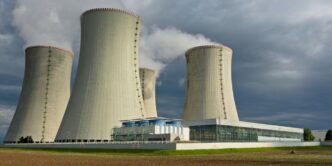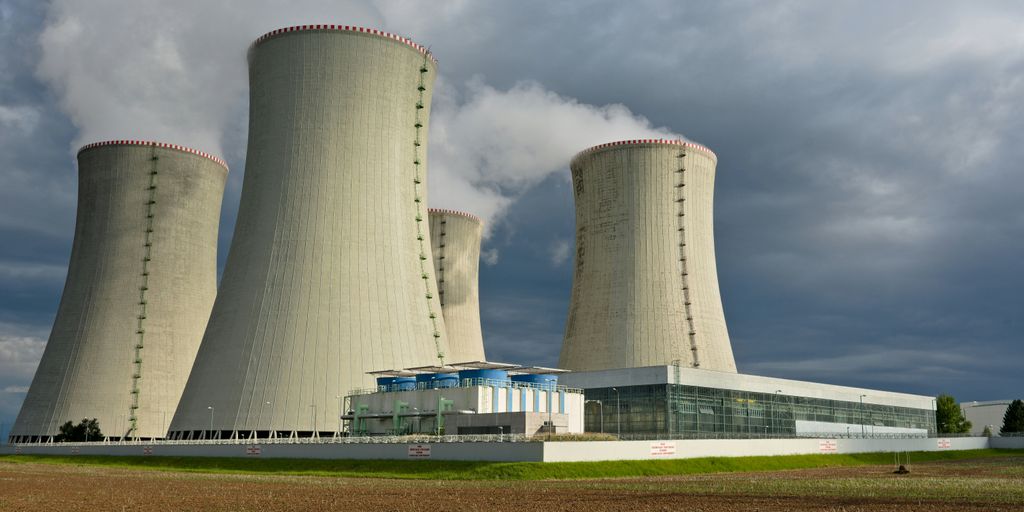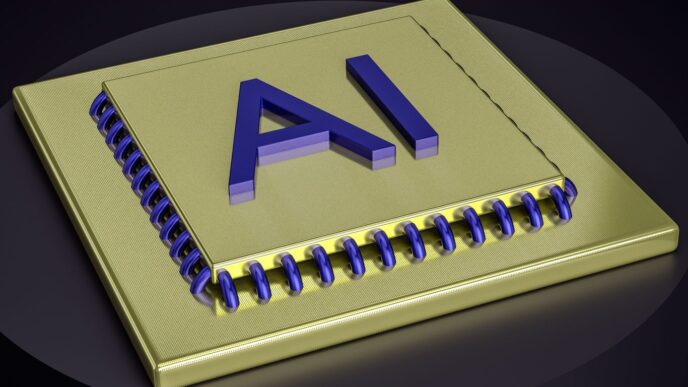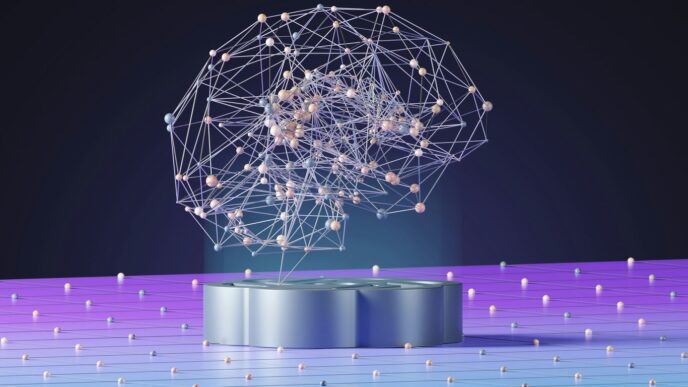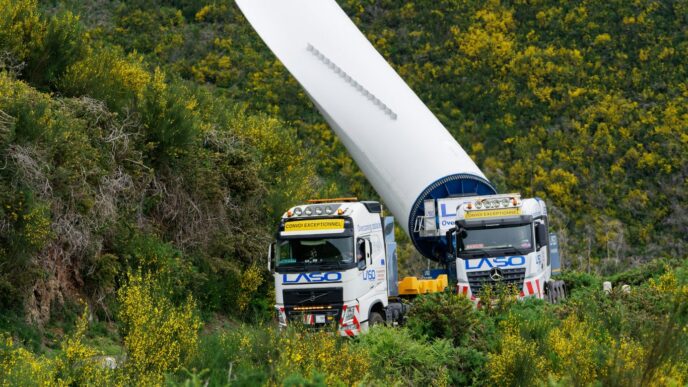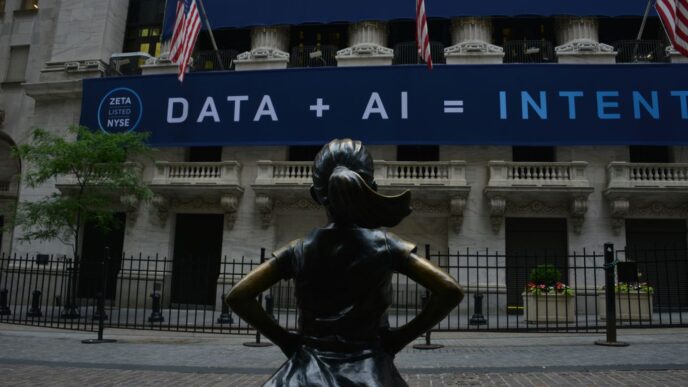So, everyone’s talking about AI these days, right? It’s everywhere, doing all sorts of amazing things. But here’s the thing: it takes a ton of power to run all that smart tech. And I mean a TON. This has got a lot of big companies, the ones making all the AI stuff, looking at nuclear energy as a possible answer. It sounds pretty futuristic, like something out of a sci-fi movie. But is it really the way to go, or are we just trading one set of problems for another? Let’s dig into this whole ai nuclear energy idea and see what’s what.
Key Takeaways
- AI’s growing energy needs are pushing tech companies to consider nuclear power.
- Big tech players like Microsoft and Google are investing in nuclear projects.
- Nuclear energy offers continuous power and helps with decarbonization goals.
- Challenges include regulatory hurdles, high costs, and a shortage of skilled workers.
- Dealing with nuclear waste and preventing weapons spread are still big concerns.
The Growing Energy Demands of AI

AI is everywhere now, and it’s not just some cool tech fad. It’s woven into pretty much every major tech innovation we see. Think about those personalized recommendations on Instagram or the complex AI models. All that stuff needs a ton of computing power, and that computing power translates directly into huge energy demands.
AI’s Insatiable Power Consumption
AI’s hunger for power is kind of mind-blowing. Just to give you an idea, ChatGPT deals with something like 200 million requests every single day. And get this: generating just one AI image can use about the same amount of energy as fully charging your smartphone. It’s easy to see how AI-driven data centers have significantly increased electricity consumption. The numbers are only going to go up, and that’s a problem.
Tech Giants Eyeing Nuclear Solutions
So, what’s the answer? Well, some of the biggest tech companies are starting to look at nuclear energy as a serious option. They’re realizing that traditional energy sources might not cut it when it comes to powering their AI ambitions. Existing nuclear power might not be enough to satisfy the demand for energy. OpenAI’s CEO Sam Altman lamented that we don’t appreciate the energy needs of AI technology.
The Search for Sustainable AI Power
Finding a sustainable way to power AI is becoming a major focus. It’s not just about having enough energy; it’s about having energy that doesn’t wreck the planet. This is where things get tricky. We need to figure out how to balance the growing energy demands of AI with our goals for a cleaner, more sustainable future. There’s even an initiative focused on getting the semiconductor industry back on the path of doubling energy efficiency every two years.
Big Tech’s Nuclear Ambitions
Microsoft’s Strategic Nuclear Investments
Microsoft is making some serious moves in the nuclear energy space. It’s not just about buying power; they’re putting money into developing the next generation of reactors. This is a big deal because it signals a long-term commitment to nuclear as a key part of their energy strategy. They’re clearly thinking ahead, anticipating the massive power demands of future AI and data centers. It’s a bold move, and it shows they’re willing to invest in potentially risky but high-reward energy sources.
Google’s Foray into Nuclear Technologies
Google is also getting in on the nuclear action. They’ve investing in advanced nuclear energy projects with Elementl Power. This isn’t just about keeping the lights on; it’s about securing a reliable, carbon-free energy source for their data centers. The amount of electricity these data centers use is insane, and it’s only going to go up as AI gets more complex. Google sees nuclear as a way to meet those demands while also hitting their sustainability goals. It’s a smart play, and it shows they’re serious about reducing their carbon footprint.
Meta’s Bet on Nuclear Power
Meta, not to be left out, has also placed its bet on nuclear. They’ve signed a 20-year deal with Constellation Energy to power their operations. This is a huge commitment, and it shows they’re confident in nuclear’s ability to deliver reliable, clean energy. It’s also a sign that they’re taking their environmental responsibilities seriously. With all these tech giants jumping on the nuclear bandwagon, it’s clear that nuclear is becoming a major player in the energy landscape.
Here’s a quick look at the big tech companies and their nuclear moves:
- Microsoft: Investing in next-gen reactor development.
- Google: Partnering with Elementl Power on advanced projects.
- Meta: Signed a long-term power deal with Constellation Energy.
The Allure of Nuclear Energy for AI
AI is power-hungry, no doubt about it. All those calculations and data crunching? It takes a lot of juice. So, naturally, people are looking at nuclear energy as a potential solution. It’s not just about having enough power, but also about where that power comes from. Let’s get into why nuclear is so appealing in the age of AI.
Meeting 24/7 Power Requirements
AI doesn’t sleep. It’s always working, always learning. That means the data centers that power AI need to be running constantly. We’re talking 24/7, 365 days a year. Solar and wind are great, but they’re not always available. Nuclear, on the other hand, can provide a steady, reliable stream of electricity, making it a good fit for the always-on demands of AI. The 24/7 power requirements of AI are a key factor driving interest in nuclear.
Decarbonization Goals and AI Nuclear Energy
Everyone’s talking about reducing carbon emissions, and big tech is no exception. They’ve got goals to meet, and powering AI with fossil fuels isn’t going to cut it. Nuclear energy is a low-carbon source of power, which means it can help tech companies reduce their carbon footprint while still meeting the energy demands of their AI systems. It’s a way to be both powerful and, well, less bad for the planet. Decarbonization is a big deal, and nuclear offers a way to achieve it.
Investment in New Generation Assets
It’s not just about using existing nuclear plants. There’s a lot of talk about investing in new types of nuclear reactors, like small modular reactors (SMRs). These are smaller, potentially cheaper, and maybe even safer than traditional reactors. The Department of Energy sees potential for a commercial liftoff that could triple US nuclear capacity by 2050. For example, companies are looking at sodium-cooled fast reactors. The idea is that these new technologies could make nuclear power more accessible and more appealing for powering AI. It’s a long-term investment, but one that could pay off big time.
Challenges and Setbacks in AI Nuclear Energy Development
Regulatory Hurdles and Approvals
Getting anything nuclear-related approved is a slog, plain and simple. The Nuclear Regulatory Commission (NRC) is known for its rigorous, and often slow, processes. Remember Oklo’s attempt to get a small modular reactor approved? They were denied for lack of information back in January 2022, and haven’t even resubmitted. It’s not just about safety, although that’s a huge part. It’s also about navigating a maze of regulations that can take years, even decades, to sort through. This kind of delay can kill momentum and make investors skittish. Big tech’s adoption of nuclear power reveals a common strategic hurdle for AI and energy sectors: effective time management. This challenge is amplified by the increasing demands of AI-driven data.
High Costs and Long Construction Times
Building nuclear plants isn’t cheap. We’re talking billions of dollars, and that’s before you even pour the first concrete. The initial investment is massive, and the payoff is way down the line. Plus, these projects take a long time to complete. We’re talking 5-10 years, maybe even longer, from groundbreaking to actually generating power. That’s a tough sell when AI development is moving at warp speed. The expense of powering chatbots is already climbing so fast that companies are holding back their newest versions from the public.
Workforce Shortages in the Nuclear Sector
It’s not just about money and regulations; there’s a people problem too. The nuclear industry has been shrinking for years, and a lot of experienced workers are retiring. Finding qualified engineers, technicians, and construction workers to build and operate these new plants is a real challenge. We need to train a whole new generation of nuclear professionals, and that takes time and resources. The workforce needed to build a host of nuclear projects has dwindled as plants have closed and not been replaced. Also, none of the proposed new projects has included any new ideas for what to do about the radioactive waste generated not only by reactors by also by uranium mining.
Addressing Nuclear Waste and Proliferation Concerns
Okay, so, nuclear energy sounds great for powering AI, right? But let’s not forget the big elephants in the room: nuclear waste and the risk of nuclear weapons spreading. These aren’t new problems, but they get a fresh coat of worry when we talk about scaling up nuclear to feed AI’s hunger for power. It’s like, are we solving one problem by creating a potentially bigger one?
The Unresolved Problem of Radioactive Waste
Seriously, what do we do with all that waste? It sticks around for, like, forever. There’s still no permanent repository for long-lived radioactive waste in the United States. We’re talking about materials that need to be isolated for thousands of years. That’s a long-term commitment, and honestly, nobody seems to have a perfect answer. Some people talk about new technologies that could reduce nuclear waste, but even those ideas still need a place to put the stuff. If we want to protect future generations, we have one solution — it is to put it in a deep geological repository.
- Current storage solutions are only temporary.
- Finding suitable long-term storage sites is politically difficult.
- New technologies like Waste to Stable Salt (WATSS) processing are promising but not a complete solution.
Risks of Nuclear Weapons Proliferation
This is the scary part. More nuclear power plants mean more opportunities for nuclear materials to fall into the wrong hands. And it’s not just about governments. The risk that fissile material could be acquired by terrorists is real. Some newer reactor designs, like fast reactors, actually produce materials that could be used to make weapons. That’s not exactly reassuring. It’s a complex issue, but we can’t just ignore it. The US rejected reprocessing in the 1970s after determining that the potential for proliferation made it too risky for commercial use.
Safe Disposal and Reprocessing Challenges
So, what are the options? Well, there’s disposal, which we already talked about. Then there’s reprocessing, which is basically recycling used nuclear fuel. Sounds good, right? But reprocessing produces plutonium that could be diverted for use in nuclear weapons. That’s why the US has a well-established and well-exercised safeguards regime that accounts for special nuclear material. Plus, reprocessing is expensive and complicated. It’s not a simple fix, and it comes with its own set of risks. We need to think long and hard about the best way to handle this stuff, because the stakes are pretty high. The vast amounts of raw materials and water required for the growth of both AI and nuclear energy, or the electronic waste, are also a concern.
The Future Landscape of AI Nuclear Energy
Potential for Commercial Liftoff by 2050
Okay, so picture this: it’s 2050, and instead of just talking about AI and nuclear energy, we’re actually seeing it happen. The Department of Energy thinks there’s a real shot at a "commercial liftoff" that could triple the US nuclear capacity. That’s a big deal! They’re saying that AI’s crazy energy needs are lining up perfectly with what nuclear can offer – 24/7 power, a push for less carbon, and investments in new power plants. It’s like the stars are aligning, maybe. But, you know, it’s still a long way off, and lots could change.
AI’s Role in Expediting Nuclear Approvals
One of the biggest headaches with nuclear energy is how long it takes to get anything approved. Seriously, the red tape is insane. But here’s where AI could be a game-changer. Microsoft, for example, is already planning to use AI to speed up the approval process for new nuclear plants. They’re even training an AI model on all those regulatory documents. Imagine if AI could cut through the bureaucracy and get these plants up and running faster. That would be huge.
The Inextricable Link Between AI and Nuclear
Some people think AI and nuclear energy are destined to be together. OpenAI’s CEO, Sam Altman, has said he doesn’t see how we can meet AI’s energy demands without nuclear. He’s even calling for more investment in nuclear fusion and fission. Bill Gates is also betting big on nuclear startups. It’s like they’re saying, "AI needs power, nuclear is power, so let’s make this happen." But it’s not a done deal. There are still plenty of challenges to overcome, like dealing with nuclear waste and making sure everything is safe. But the potential is definitely there.
Wrapping Things Up
So, where does all this leave us? It’s clear that AI needs a lot of power, and nuclear energy looks like a possible answer for some big tech companies. But it’s not a simple fix. There are still big questions about how much it costs, how long it takes to build, and what we do with all the waste. It’s a complicated situation, and we’ll have to see how it all plays out. Maybe it’s a good idea, maybe not. Only time will tell.
Frequently Asked Questions
Why do AI systems need so much energy?
AI systems, especially the big ones, use a lot of electricity. Think of it like a super-powerful computer that needs constant energy to run. As AI gets smarter and does more things, it needs even more power.
Why are big tech companies interested in nuclear power for AI?
Big tech companies like Microsoft, Google, and Meta are looking at nuclear power because it can provide a steady, always-on supply of electricity. They want to make sure their AI operations never run out of power.
What are the main benefits of using nuclear energy for AI?
Nuclear power plants can run all day, every day, providing a constant stream of electricity. This is perfect for AI, which needs power around the clock. Also, nuclear energy doesn’t produce carbon pollution, which helps companies meet their clean energy goals.
What are some problems with using nuclear energy for AI?
There are several big challenges. Building nuclear plants is very expensive and takes a long time. There are also many rules and approvals needed from the government. Plus, there aren’t enough skilled workers to build all these new plants.
What about nuclear waste and the risk of nuclear weapons?
One of the biggest problems is what to do with nuclear waste, which is radioactive and dangerous for a very long time. There’s also a worry that nuclear materials could fall into the wrong hands and be used to make weapons.
What does the future hold for AI and nuclear energy?
Experts think that nuclear energy could become a major power source for AI by 2050. AI itself might even help speed up the process of getting nuclear projects approved. It seems like AI and nuclear power are becoming very connected.

